Vision 2025 - National Research Centre for Grapes
Vision 2025 - National Research Centre for Grapes
Vision 2025 - National Research Centre for Grapes
You also want an ePaper? Increase the reach of your titles
YUMPU automatically turns print PDFs into web optimized ePapers that Google loves.
8. ISSUES AND STRATEGIES<br />
8.1 CROP IMPROVEMENT<br />
i. Introduction and development of early ripening varieties and rootstocks to meet the<br />
specific requirements in north western plains, northeast and eastern India in terms of short<br />
period available <strong>for</strong> ripening, high rainfall, water logging and high water table.<br />
Standardization of agrotechniques of existing varieties to meet the specific requirements of<br />
these areas.<br />
ii. Introduction of table and wine varieties having relevance to tropical viticulture and market<br />
importance both in domestic and export market, from USA, South Africa, Australia and<br />
EU countries particularly Mellisa / Princess, Tudor Red Premium, Regal Seedless, Sunred<br />
Seedless, Cristelle Seedless, Blush Seedless, Prime Seedless, Autumn Seedless, Emperor,<br />
Marquis, Dogridge Clone 01 and 05 and IAC 572, Fercal, Schwarzmann have relevance to<br />
Indian situation. Introduction of varieties with more keeping quality is required.<br />
iii. Breeding of varieties with least apical dominance, high fruitfulness at the base, selfthinning<br />
and resistance to tropical diseases and insect pests.<br />
8.2 CROP PRODUCTION<br />
i. The present cost structure <strong>for</strong> non-recurring and recurring expenditure works out to be Rs.<br />
8.0 lakhs and 2.5 lakhs / ha respectively <strong>for</strong> table grapes. The major inputs are material<br />
required <strong>for</strong> training, manures / chemical fertilizers, plant protection and other chemicals<br />
and labour. High cost of cultivation and timely availability of skilled labour are the major<br />
impediments to promote Indian viticulture on large scale. Hence, reducing the nonrecurring<br />
and recurring costs and thereby reduction in the total cost of production to make<br />
Indian viticulture more cost competitive at global level is required.<br />
ii. Evolving cultural practices including training systems <strong>for</strong> table, wine and raisin grapes<br />
grafted on new potential rootstocks to increase the fruitfulness of buds and their sprouting<br />
after fruit pruning, quality of fruits and optimum yield, shelf life and quality of processed<br />
products like juice, wine and raisins. Evaluation of alternate pruning practice to stagger the<br />
harvest in tropical region to overcome the problem of market glut.<br />
iii. Minimizing the cost of manuring by avoiding over-manuring and strictly going by need<br />
based nutrient schedule based on leaf petiole analysis at the time of fruitfulness and bud<br />
differentiation apart from soil analysis after harvesting the crop. Further, there is need to<br />
increase the fertilizer efficiency by <strong>for</strong>mulating economic and efficient manurial schedule<br />
involving time, method, sequence and <strong>for</strong>m of nutrient application.<br />
iv. Reducing the cost of labour, since grape cultivation is labour intensive farming enterprise.<br />
Some cultural operations like pruning, spraying, growth regulator treatments and thinning<br />
requires a large number of labours during a short span of time. Availability of labour on<br />
such a large scale at short time notice from small villages or small inhabitants is not<br />
possible. Further, all the operations identified <strong>for</strong> manual cannot be mechanized,<br />
particularly thinning and harvesting requires lot of care in handling bunches since, delicacy<br />
is involved. Considering these aspects, mechanization of operations to be decided and the<br />
strategy to be worked out accordingly.<br />
28





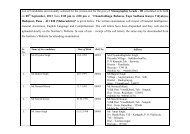
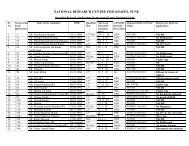

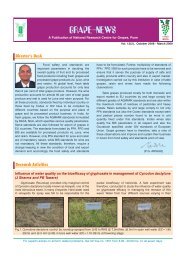

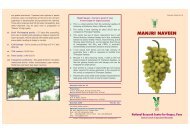
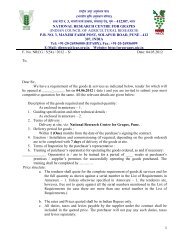



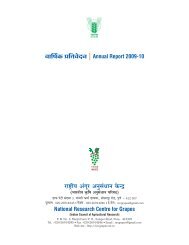
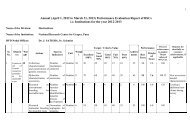
![mj]mJ{V cmcH$m{irM{ (_mBQâ¤>g) oZ`ÃÃU](https://img.yumpu.com/33367555/1/190x127/mjmjv-cmchmirm-mbqag-ozaau.jpg?quality=85)